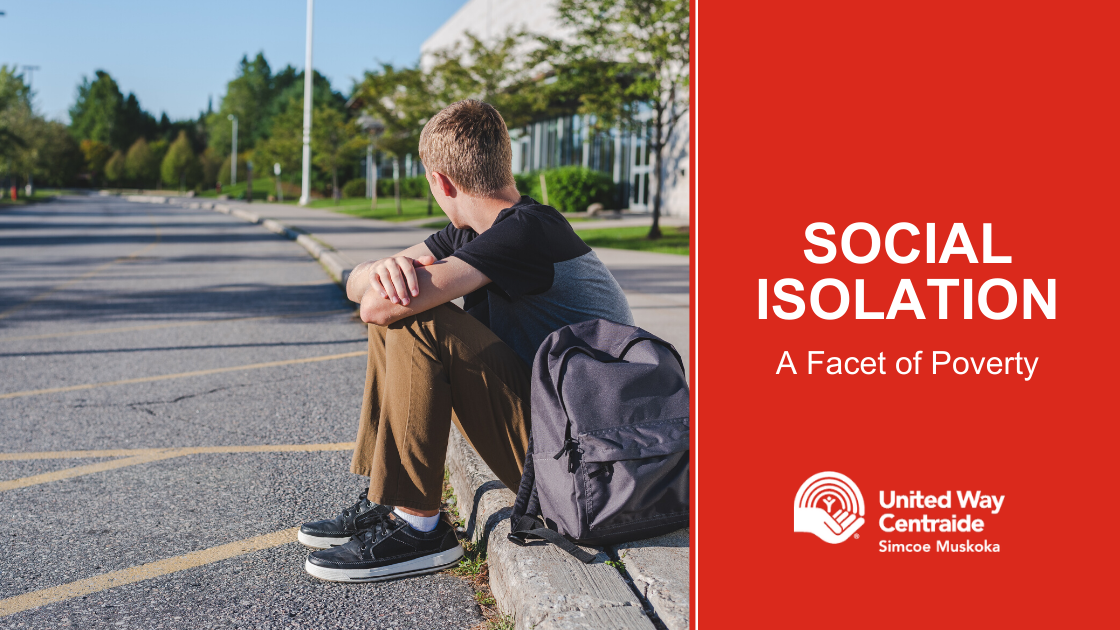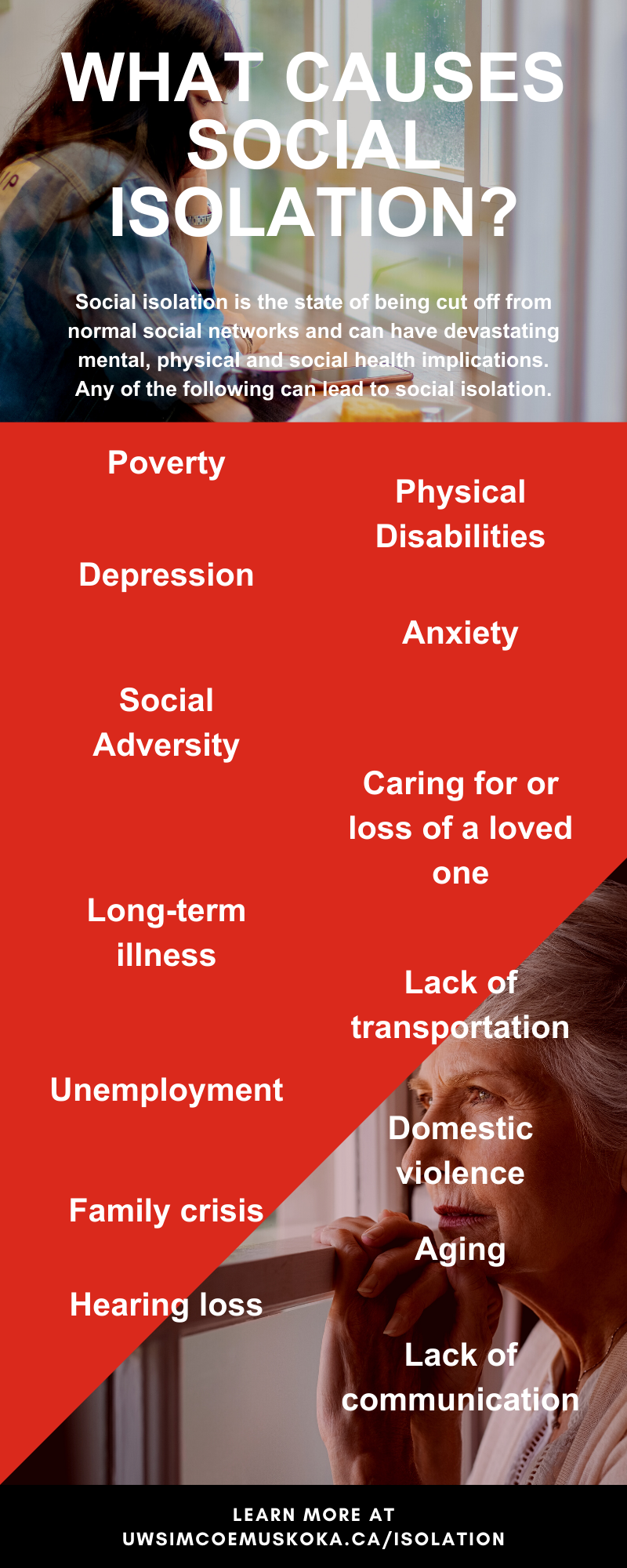
28 Apr Social Isolation – A Facet of Poverty
Social isolation is a devastating yet sometimes invisible facet of poverty. Now, during the uncertain times of the COVID-19 pandemic, the effects that social isolation has on individuals experiencing it have become magnified.

What is Social Isolation?
Social isolation is the state of being cut off from normal social networks, aside from those that are required for basic aspects of life, such as interacting with a bank teller or grocery store cashier. It means that the number of meaningful interactions a person has can be easily counted. Even surrounded by people, a person can be socially isolated.
Isolation can be caused by a number of factors. The most common cause of social isolation is a physical disability that can create barriers that stop someone from leaving their house. Not every obstacle is physical when it comes to social isolation, though. Any one of the following factors can cause social isolation:
- Depression
- Anxiety
- Social adversity
- Caring for a loved one
- Bereavement
- Long-term illness
- Lack of transportation
- Unemployment or underemployment
- Economic struggles
- Domestic violence
- Family crisis
- Living alone
- Aging
- Hearing loss
- Lack of communication (due to no cell phone or ability to pay for a plan)
While social isolation can occur at any point during someone’s life, it becomes more common as we age due to physical factors like hearing loss. That being said, children in school can experience social isolation due to family dynamics, bullying and economic circumstances.
Unfortunately, social isolation tends to impact individuals from specific social groups as well. These groups include seniors, youth, people with disabilities, members of the LGBTQ+ community, First Nations peoples, and newcomers and immigrants. It’s important to remember though that anyone can experience social isolation.
The Impact of Social Isolation
There are a wide range of social, mental and even physical impacts that isolation can have on an individual.
Isolation can lead to loneliness, a fear or distrust of others or even a sense of being threatened by strangers or those you know. It can even strain what few existing relationships someone might have. These effects can then entrench someone deeper into social isolation.
Being secluded from society can also cause increased rates of depression, anxiety and negative self-esteem, which are all potential causes of isolation in the first place.
As for physical impacts, Dr. Steve Cole of the University of California’s Social Genomics Core Laboratory says that loneliness and isolation act as “fertilizer for other diseases. The biology of loneliness can accelerate the buildup of plaque in arteries, help cancer cells grow and spread, and promote inflammation in the brain leading to Alzheimer’s disease.” In addition, social isolation has been linked to high blood pressure, heart disease, obesity, cognitive decline and death. Substance abuse has also been noted as both a cause and result of social isolation.
In Seniors
Many of our seniors are already at an increased health risk due to COVID-19, but approximately 1 in 4 seniors are already living with social isolation before distancing measures have been put into place.
Retirement, the end of daily work relationships, loss of friends and loved ones, and the physical changes that accompany aging can all lead to social isolation. Hearing loss, in particular, leads to an inability to communicate and can cause people to feel alone even in a room of their family and friends.
In addition to the effects listed above, isolated seniors have also shown increased cholesterol, elevated stress hormones, weakened immune systems and an increased risk of dementia compared to those who have meaningful social interactions.
In Youth
For children and youth, a sense of belonging is critical to create positive social and emotional well-being and is strongly linked to academic success. Without this sense of belonging, the most common and debilitating effect of isolation on youth is depression. This depression might not manifest during adolescence either, but could come back later in adulthood as a result of not belonging while younger.
Among youth and children, it’s been shown that friendship-related isolation is far more harmful than parent-related isolation.
Social Isolation vs Loneliness
While the two sound similar, they are not necessarily the same. As stated before, isolation is an objective state of being cut off from society, where social interactions can be counted. Loneliness, on the other hand, is subjective.
Loneliness is also temporary, while isolation is ongoing. Both are painful experiences with detrimental impacts, but they are not synonymous, and loneliness is frequently one of the symptoms or causes of isolation.
Social Isolation vs Social Distancing
In the news, on social media and while talking with others, you might hear social isolation used synonymously with social distancing. In reality, the two are completely different and it is important to understand the difference.
Social distancing is voluntary and temporary. It’s a way to slow the spread of a disease like COVID-19 and ease the burden on our healthcare system. As we’ve discussed in this blog, social isolation is neither voluntary nor temporary.
The effects of social distancing can make the social isolation even more harmful, though. While we work together to weather the novel coronavirus, the reduction in available services mean that those who are isolated do not even get the basic social interactions provided by non-essential services, like a cashier at a coffee store. It has also caused many important services for seniors and those living with mental health challenges to shut down, reduce their hours or change the way they deliver assistance.
It means that those who need these services aren’t able to access them, which isolates an individual even more.
That’s why United Way Simcoe Muskoka has created the COVID-19 Fund, to help those who are struggling with accessing their basic needs during this crisis and to extend community supports for seniors and those living with mental health challenges. And, thanks to two community leaders who wish to remain anonymous, all gifts up to $20,000 to the COVID-19 Fund are doubled.
That means your gift goes twice as far and delivers twice the impact for those who need it most during this pandemic. During these unprecedented times, it is up to all of us to come together and help those most vulnerable.
Click here to donate to the COVID-19 Fund and have your gift matched.



Sorry, the comment form is closed at this time.